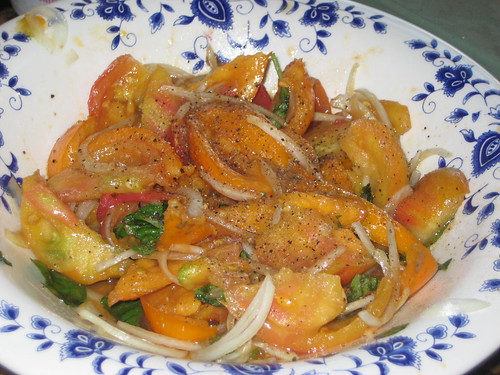grocery wars
I'd prefer to write about this epic struggle, but one can only dwell in fantasy for so long. The top business story in Sunday's St. Paul Pioneer Press, "Food Fight," details the present landscape of mainstream grocery stores in our oft named battleground state. Well written and detailed, the piece describes how grocery market share in MN has changed over the past few years, particularly in the Minneapolis/St. Paul metro area.
The overarching trend discussed in the article is clear: huge, extreme discount stores - mainly Walmart and Target - are attracting more and more shoppers away from Minnesota-based or regional chain stores, such as Kowalski's, Cub Foods, and Rainbow Foods. Many key issues are addressed, including unionization, loss-leaders, and extreme discounting (Walmart vs. Cub). Aside from the fact that co-ops and co-op-like stores aren't mentioned in the article, the most interesting part (for me) is the perspective offered by and about smaller grocery retailers, such as Kowalski's. Here's an excerpt:
The nine-store Kowalski's strategy is to hunker down, focus on quality and see when the economy improves, said Jim Kowalski. "We're not doing any growth right now," he said. "We don't pretend to compete in the price wars that seem to be going on."
Let's face it. There are at least as many types of grocery shoppers as there are brands of frozen pizza at Cub Foods (which was 27 last time I checked). Some people are loyal to one store, at which they buy everything. Others play hopscotch with several retailers, buying different items across multiple stores. Still others are perhaps a bit more schizophrenic, shopping at a different store depending on immediate geographic location (work, school, neighborhood) or emotional state (indulgent, frugal, or green). Such is the state of our food culture.
I am not a grocery store business expert or analyst, but I do buy a lot of food and attempt to follow these trends closely. To date, I have spent money at nearly every grocery retailer mentioned in the article, the exceptions being Aldi's/Trader Joe's and Walmart/Sam's Club. However, for the past 5 years or so, I've chosen to abandon corporate grocery stores in favor of co-ops, of which there aren't nearly enough. That's a different blog post altogether.
What if the challenge Kowalski's faces is an opportunity? A crowded market is dangerous for business as usual, so perhaps the time is right for some lasting innovation among smaller grocers. Jim Kowalski's quote acknowledges that his stores, despite their focus on "quality" (whatever that means), cedes a defeatist outlook by using expressions like "hunker down" and a lack of "growth." He claims to not "pretend to compete in the price wars," but his market share has decreased as a result of shoppers migrating to newer, bigger stores. He doesn't compete because he can't, at least not solely on the price of Brazilian orange juice concentrate, yet he would like to open additional stores.
Fundamentalist discount shoppers seek the lowest prices on food products, without much (or any) regard for the costs associated with producing, distributing, or selling those products, such as the energy (e.g. gasoline), environment (e.g. chemical pesticides), and community (e.g. wages). Smaller grocers should forget about these people. They live on a different planet or will have to soon.
Rather than use the same vocabulary and approach to growth (i.e. increasing profits, number of stores, and market share), smaller grocers should be and celebrate what the super stores are not: progressive, community-building organizations that sell healthy, fairly priced products (a lot of which are local) and create sustainable, livable jobs. If the tremendous growth of farmers' markets is any indication, there is an increasingly vocal segment of the grocery-buying public that seeks a different choice. Find them and sell them what they want. Co-ops have figured this out, so why can't the local supermarket? Such an outlook may squash a regional executive's dream of creating the next national chain store, but within a different framework, that executive no longer will be needed, and neither will the additional 5 stores he or she hoped to open. A small, efficient neighborhood store can hold a reasonable monopoly. Why must we always need more?
Here's an idea. Maybe the Kowalski's in Stillwater could sell meat, dairy, and produce from the St. Croix river valley, and the Grand Avenue store could sell products from Gardens of Eagan. Add a kick-ass bulk section and show people how to use it. If you can't compete on the price of Tyson chicken fries, then sell real chickens from Callister Farm. Think differently. Yes, these products cost more, but an educated customer understands and appreciates the quality of such products. If I want to find the lowest price on crap I will travel to the cheapest crap heap, of which there are many.
Perhaps a plant analogy is appropriate: grow and manicure a small but healthy bonsai that lives for 200 years, rather than 10,000 acres of wood-pulp aspens to be harvested en masse, or consumed by fire, in a few short decades.

